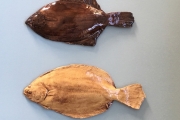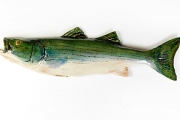In the early 1980’s I was making wood sculpture. I was also making large drawings and prints. At this time I never thought of clay as a serious sculptural material. Something in me was curious about what would happen if I made a plaster mold of a freshly caught fish, not unlike the Japanese fish printing process where a fish is rolled onto a soft paper. My intent was to force clay into a mold, creating a clay positive in relief. In 1988 I made my first ceramic fish by creating a mold from a very large blue fish that I had caught. I was soon making molds of different fish experimenting with color and glazing techniques. I was educating myself to learn glaze formulations to give me the effect I wanted. I showed these pieces singularly on the wall.
It was at this time that I became aware of traditional Portuguese crab and lobster plates, which I saw at Friends Market in Providence, R.I. I thought these were wonderful images, a single crustacean mounted on a plate with various sea elements mixed in. I began to visit museums to search their decorative arts collections, curious about what else might be out there. It was in these collections I discovered Bernard Palissy and Palissyware. Palissy was a French artist from the 15th century who made ceramic plates embellished with creatures from the forest. Palissyware is a name given to work that is made in the tradition of Bernard Palissy. To this day, he is revered as an important artist that employed clay as a medium. It is here I found a place to begin my work.
I began to build a collection of various molds taken from nature and started building compositions on a clay background, that reminded me of landscape or things that I had seen while walking. These felt more fulfilling and opened up possibilities of expressing complex ideas compared to singular fish.
While employing molds in creating my work, I don’t rely on them exclusively. I enjoy handling clay, creating forms with my hands, carving the clay. It is important to me to touch the clay in all its stages, while it’s wet, while it’s leather hard and while it’s dry. In the end, what I’ve found in the clay and the color achieved through glaze is an ability to create a small, but highly charged object.



